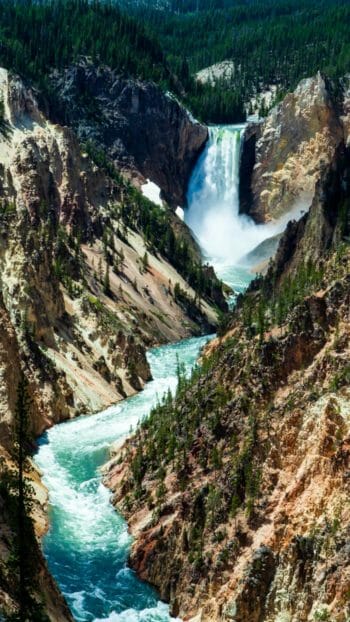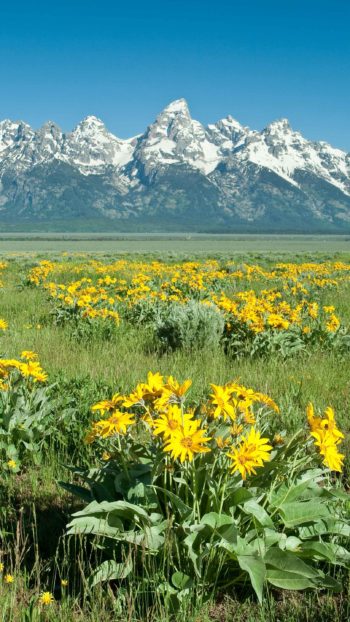The Mating Habits of the Greater Sage-Grouse
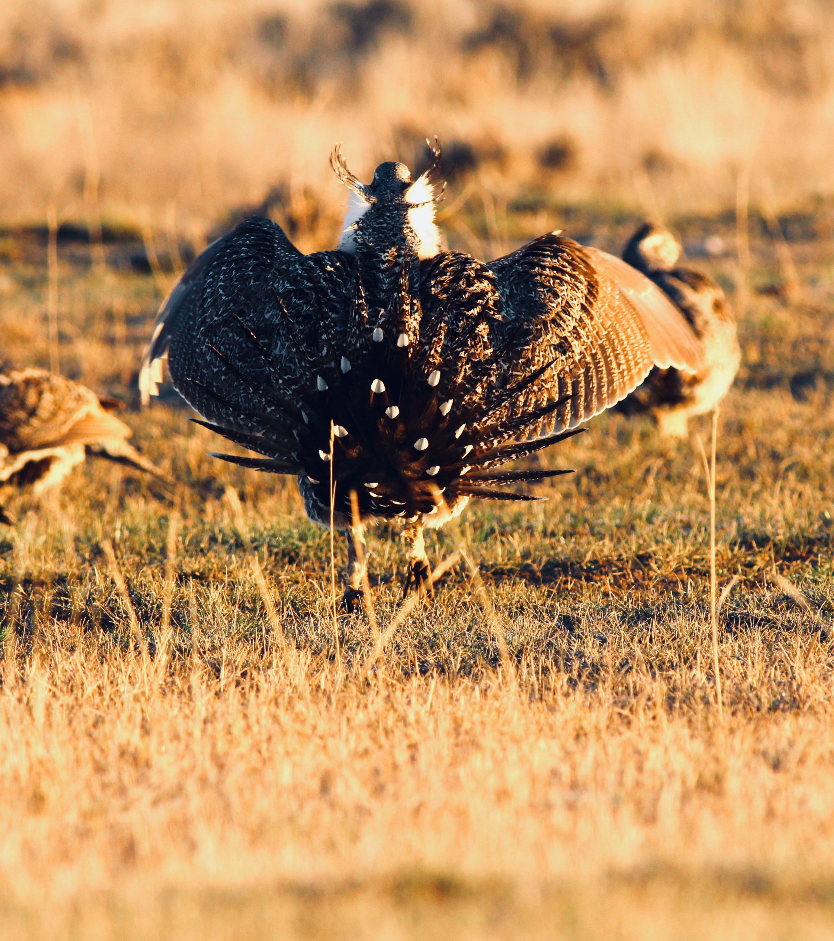
Why We Should Pay Attention
McKinzie Fink was a recent graduate with a Bachelor’s Degree in Wildlife Science when ended up with a very peculiar job duty. She knew she wanted to study wildlife and also wanted to see remote parts of the United States that she might not otherwise travel too. She ended up pursuing work in the barren sagebrush steppes of central Wyoming, where the closest town was Hudson, WY, which had a human population of a little more than 400. From March until May, her sole focus was on the greater sage-grouse. She had never encountered this unique avian species before, and all of a sudden she found herself waking up hours before dawn to drive out to where they gather in the morning to breed. From a blind located on a hill above these breeding grounds, she used a high powered spotting scope and a camera to observe and record the mating behaviors and copulations of these birds. Thus, after watching some very dramatic avain sexual encounters for several months, she earned the title of “pornithologist”. Who says scientists don’t have a sense of humor?
Ornithologist:
\ˌȯr-nə-ˈthä-lə-jist\ noun: a person who studies, or is an expert on, birds
Pornithologist:
\ˌpɔȯr-nə-ˈthä-lə-jist \ noun: slang for a person who studies, or is an expert on, the mating rituals of birds
So what is a “greater sage-grouse” exactly? And why is it so important to study the mating behaviors of this particular bird? A greater sage-grouse is larger than a chicken but smaller than a turkey. The females are a drab brown speckled with black; the males are similar with the additional features of two inflatable yellow air sacs in their chest, a spiked fantail and black filoplumes above their eyes that look like bizarre eyebrows.
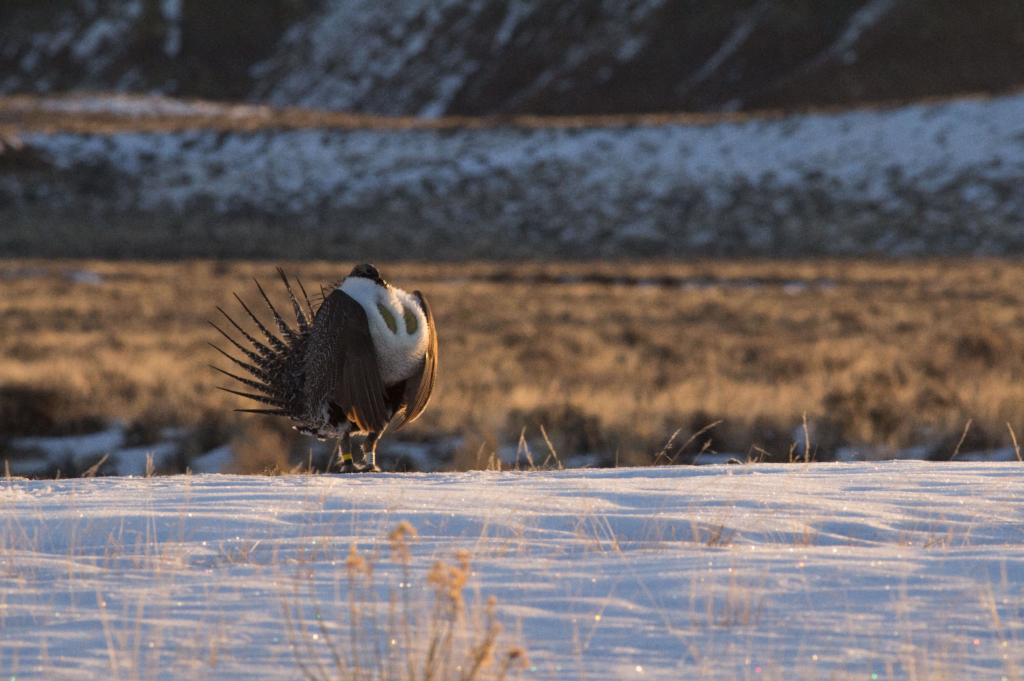
This is a large game bird that lives only in the open high desert habitats of the west where the sagebrush shrub is abundant, a habitat also known as the sagebrush steppe. As their common name suggests, greater sage-grouse depend on sage for survival. In the winter it is just about the only plant they eat, and in the summer it is in sagebrush steppes that they gather to breed and rear their young.
The population of greater sage-grouse in the United States is thought to have exceeded one million in the past, and recent studies have found less than 500,000 throughout their native ranges. A multitude of factors have lead to this population decline but threats from invasive plant species, climate change, urbanization, noise pollution from humans and overall sagebrush habitat reduction have been found to be significant contributors to their decline. Cheatgrass is a nonnative plant grows prolifically and overtakes areas that sagebrush once dominated, and native pinyon and juniper trees have been encroaching into sagebrush steppes also reducing viable sage grouse habitat. Human developments like fences and power lines are inadvertent traps that sage grouse can get caught in and die. These structures also give predatory birds an advantage when hunting. A hawk or eagle can perch on a fence post where they can easily scan for a tasty sage grouse snack or, in the case of ravens, locate sage grouse nests to raid. Studies have also found that noise pollution from highways, OHV trails, mining operations and petroleum wells built in sagebrush steppes can contribute to greater sage-grouse abandoning once viable habitats. Essentially, greater sage-grouse are picky animals, which does not work to their advantage in a world being rapidly altered by humans.
They are also creatures of habit. Generations of sage grouse will return to the same historical location every year to mate. Peak breeding season starts around March and usually ends around May, and often occurs during the early hours of the morning. The specific location they flock to for breeding is called a lek. Males will gather on the lek first and begin their courting displays, an elaborate undertaking that is best viewed, rather than described. When the hens arrive they walk amongst these courting males and select the one they want to mate with. There are usually only a few dominant males on the lek that mate with a majority of the females, and they are usually the strongest and healthiest, which is proven by the vigor of their display. The size of a lek can vary between just a couple birds, to hundreds. Just like their pickiness, this habitual behavior of returning to the same lekking grounds year after year can be a disadvantage. For instance, if an airport runway is built over a historical lek location, just as the Jackson Hole Airport is, sage grouse will continue to try to use it, and attempting to breed where airplanes are taking off and landing does not lead to as many copulations. Greater sage-grouse seem to have many factors working against them, both in outside threats and behavioral quirks that are leading to an unfortunate pattern of population decline. Watch the greater sage-grouse live cam to see a lek in real-time.
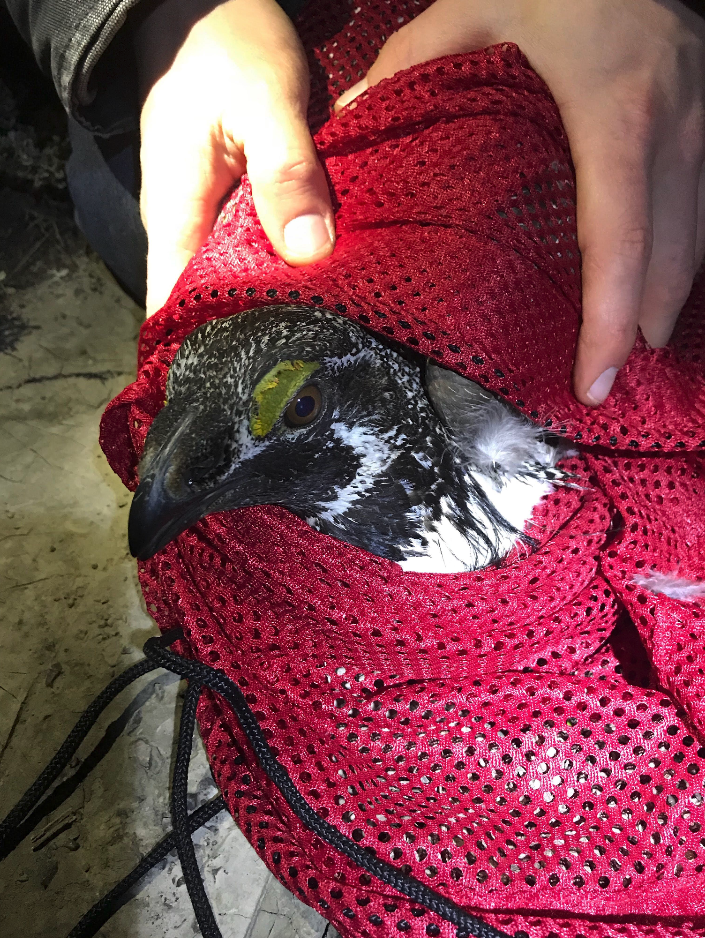
Mating Behaviors of the Greater Sage-Grouse
So what do scientists hope to achieve by monitoring mating rituals of the greater sage-grouse? There are a lot of intricacies involved that could help wildlife biologists understand what management practices will be most effective in protecting greater sage-grouse in the United States. Understanding these complex mating behaviors could reveal or emphasize factors that are contributing most to population decline. For instance, the hen will only mate with a male she deems worthy, and that male may only seem worthy if his courtship display is on point. These courtship displays require a lot of energy, so a male will need to be healthy and well fed to have the stamina needed to display throughout the morning, or potentially the entire day. This suggests that foraging availability could be vital in the reproductive success of these birds. A wildlife biologist may deduce that increasing the abundance of sagebrush plants could benefit the overall health and population of greater sage-grouse.
There is a lot of effort going into studying this one species. A species that is at the bottom of the food chain, a species that at times seems to almost be asking for its own extinction. Why invest so much in studying greater sage-grouse? Unlike apex predators, such as wolves that are more easily determined as vital to an ecosystem because they obviously help maintain balance in the food chain, greater sage-grouse are a type of “indicator species”. This is an animal that depends on a specific habitat, and is so in tune with the overall health of that habitat, that when an indicator species is not doing well it strongly suggests that the habitat is also in regression. Therefore, the overall population decline of greater sage-grouse is evidence that the sagebrush steppe ecosystem in the United States is not doing as well as can be expected. Efforts made to preserve and protect greater sage-grouse will not only benefit this species, but also benefit the sagebrush steppe, which will, in turn, benefit the entire flora and fauna that inhabit that ecosystem.
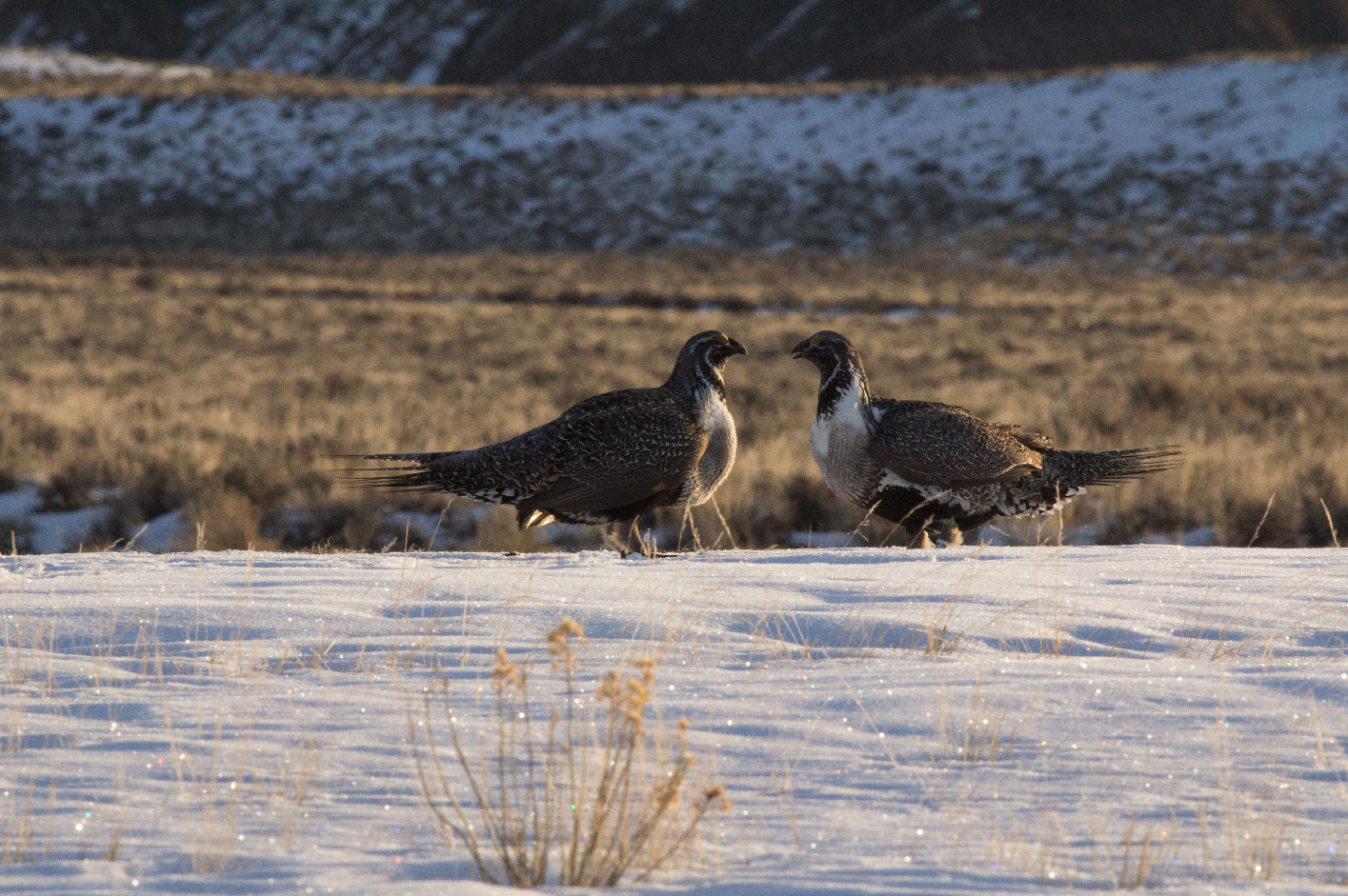
Greater Sage-Grouse & Jackson Hole
What does this have to do with Jackson Hole? This valley has a small, genetically isolated population of greater sage-grouse. Like populations outside of Jackson Hole, this one has been continually shrinking for the past century. Annual studies have revealed that the population for 2019 has dropped more than 50% from the 2018 census. The drastic decline from last year could be due to the long harsh winter the valley experienced, but the consistent gradual decline is due to many other factors. Since greater sage-grouse depend on the health of the sagebrush steppe ecosystem, it is important to understand how this ecosystem has been disturbed since the first early European settlers came to the valley. Observing areas such a Mormon Row and Elk Ranch Flats reveal large expanses of grass that had once been landscapes dominated by sagebrush. Roads now cut through the sage, fragmenting the habitat and increasing noise pollution throughout the National Park. Hotter, drier summers are leading to more intense wildfires that can decimate hundreds of acres of sagebrush. Unfortunately sagebrush does not grow quickly, and it cannot disperse its seeds over long distances, making it difficult for this plant to repopulate the landscape. These are just some challenges the greater sage-grouse in Jackson Hole are currently facing, which are similar to challenges other populations are facing throughout the western United States. This speaks to the importance of continuing to research this species, which is why the study of greater sage-grouse and their mating habits are so important to the entire ecosystem.
Blog content provided by McKinzie Fink, Jackson Hole Wildlife Safaris guide.
Consider sustainability when you travel.
Jackson Hole Wildlife Safaris combines a love of adventure with a passion for wildlife and wild spaces to create a premium, once in a lifetime experience exploring the natural world. It is our belief that active stewardship is the only way to ensure the same experience for future generations. This is why Jackson Hole Wildlife Safaris is committed to a culture of sustainability and is dedicated to purchasing products, establishing partnerships and educating the public in a way that values the protection and conservation of our most valuable resources.
Sources
Oregon Fish and Wildlife Service. Greater Sage Grouse. Retrieved from https://www.fws.gov/oregonfwo/articles.cfm?id=149489436
Coates, P.S. & et al. (2017). Pinyon and Juniper Encroachment into Sagebrush Ecosystems Impacts Distribution and Survival of Greater Sage Grouse. Rangeland Ecology & Management, 70(1), 25-38. Retrieved from https://www.sciencedirect.com/science/article/pii/S1550742416300811
Conover, M.R. & Roberts, A.J. (2016). Declining populations of greater sage-grouse: where and why. Human-Wildlife Interactions, 10(2), 217-229. Retrieved from https://digitalcommons.usu.edu/cgi/viewcontent.cgi?referer=https://www.google.com/&httpsredir=1&article=1033&context=hwi
Blickley, J.L., Hooper, S.L. & Patricelli, G.L.The impacts of noise on greater sage-grouse: A discussion of current management strategies in Wyoming with recommendations for further research and interim protections. Retrieved from https://eplanning.blm.gov/epl-front-office/projects/lup/36511/45862/49563/WildEarth%20Guardians/Attachment%2013%20Patricelli,%20et%20al.,__%20Revised%20noise%20recommendations,%202012.pdf
Forest Service Intermountain Region. (2010). Greater Sage-Grouse 101. Retrieved from https://www.fs.usda.gov/Internet/FSE_DOCUMENTS/stelprd3839884.pdf
Koshmrl, M. (2019 May 29). Biologists study emergency sage grouse import to Jackson Hole. Retrieved from http://www.buffalobulletin.com/news/state/article_7e061eae-8219-11e9-b285-1f38de5bfd25.html
